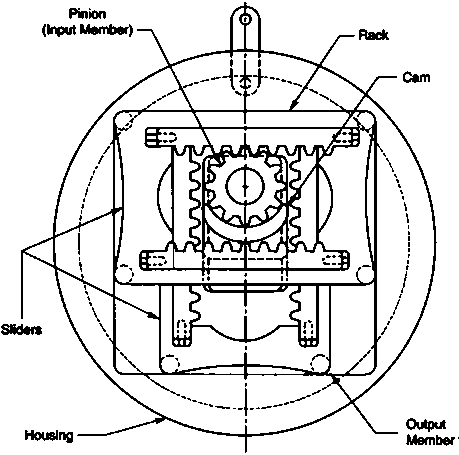Two-slider Cvt
Two-Slider CVT
A graphic representation of a CVT that operates according to the kinematic principles, a two-slider arrangement (U.S.Patent No. 4,800,768).
Specifically, each slider unit consists of two parallel racks. The spacing of the racks (w) is greater than the diameter of the pinion.
The meshing of a rack with the pinion is maintained by means of a suitably profiled cam, as shown. The two slider units are placed orthogonally.
It follows that each rack engages with the pinion at q=-p/4 and disengages at q= p/4, according to the nomenclature given in
We note from Equation that the speed ratio fluctuates periodically over periods of p/2 of the output-shaft rotation. For example, shows the variation of the output

In summary we can make the following observations regarding the present design of the CVT:
1. Speed ratio p (Input shaft speed/Output shaft speed) is not constant and changes with the shaft rotation.
2. The minimum speed ratio (pmin) occurs at the engaging and disengaging instants of a rack. The maximum speed ratio (pmax) occurs at halfway between these two points.
3. The maximum deviation from the average speed ratio is approximately 0.2 e/r and this occurs at the engaging and disengaging points.
4. Speed ratio increases linearly with e/r and hence the speed ratio of the transmission can be adjusted by changing the shaft-to-shaft offset e.
5. The larger the speed ratio the larger the deviation from the average value. It has been indicated that the speed ratio of the transmission depends linearly on the offset ratio (the offset between the output shaft and the input pinion/pinion radius).